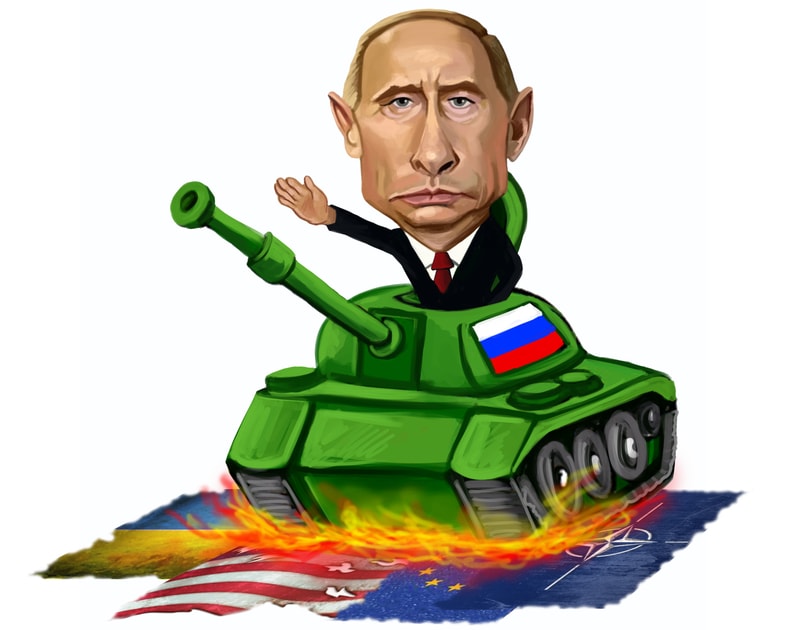
Set 30, 2022 | The Blog
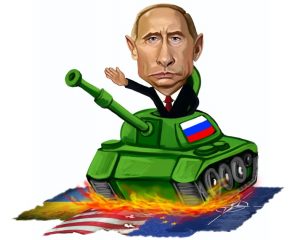
courtesy of Caricaturemaster.com
The month of September comes to a close but not without another heinous Russian war crime: a humanitarian aid convoy in the Zaporizhzhya region of Ukraine was attacked by Russian missile artillery and devastated, with the loss of at least 25 civilians.
But Russia doesn’t even care about its own losses, which are expected to go sky high after the recent mobilization, which basically amounts to railroading random civilians and dumping them on the frontlines.
The sham referendums in the occupied regions have been wrapped up. For those who thought the whole effort was a tragic farce, now there’s even video evidence to that effect. But Russia doesn’t care if the rest of the world shakes its head at Putin’s in-your-face hypocrisy. In his calculus, the bogus referendums were needed to justify the annexation of those regions. Once annexed, they’re Russia, and any Ukrainian attack is to be regarded as a violation of Russia’s borders. Hence, it’s time for Moscow to once again rattle its shopworn saber and break out the nukes (if some corrupt big-hat military honcho hasn’t already sold them for personal profit.)
The coming fall and winter will show whether the rest of the world will find the strength to call Putin’s bluff.
On a positive note, the Russian tyrant’s talk-show 3-S sycophants (Solovyev, Skabeeva, Simonyan) sound pretty downbeat these days.
I remember that just a few weeks ago they were even advocating nuclear strikes on London, while now that they witness the destruction of the Russian military and the rising popular rejection of the “partial” mobilization, they appear resigned and uncharacteristically deflated—which for monumental gasbags is no mean feat.
Ukraina Peremozhe. Ukraine will prevail.
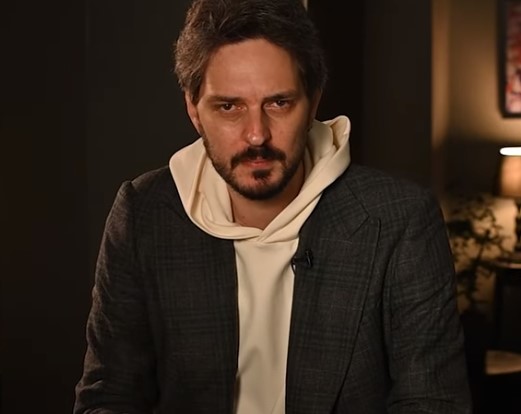
Set 12, 2022 | The Blog
In the space of a few days, the mood in Russia has changed.
Ukraine has made a superbly effective surprise move and caught the Russians totally unprepared.
While conducting a deliberate counteroffensive in the south, in the Kherson Oblast, Kyiv’s forces have suddenly overrun the front in the north-east of the country, where the Russians had been lulled into a state of complacency. The Ukrainian military’s overall strategy is nothing but textbook “Blitzkrieg.”
Thousands of Russian soldiers have been killed, thousands more have surrendered, and the amount of weaponry the Ukrainians have captured is staggering. Precious stores of arms and ammunition are now being put to good use by the Ukrainians. This—and the western supplies of military vehicles, guns and ammunition still flowing in—is effectively feeding the Ukrainian war machine on its way to driving back the Russians all the way to the Federation’s western borders.
What next?
With the Kharkiv Oblast and the Donbass free of invaders, Ukraine will be able to devote its full attention to Crimea.
A quick dash from the Donbass towards the south-west coupled with pressure from the Kherson area can compromise the survival of a large Russian force occupying the Kherson Oblast and the Azov Sea coast. If they haven’t fled already, they’ll retreat into Russia in the direction of Rostov—or try their luck fleeing into Crimea.
The Crimean Peninsula, once Kherson is liberated, will turn into a gigantic mousetrap. The Ukrainians have the resources to seal it shut by blowing up the Kerch bridge (the only remaining way out to Russia) and then pick off the Russians like fish in a barrel. There’ll be thousands of “Z” zombies waving white flags in surrender and many more pushing up the sunflowers next year.
This never-in-a-million-years scenario has now become utterly possible. Russian propagandists, true scum of the earth, have suddenly changed their tone. Only the chronic imbeciles, like Putin’s aide Medvedev and foreign minister Lavrov, still utter loud threats that no-one believes anymore.
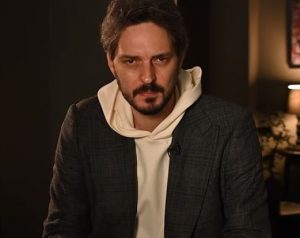 The TV-show pundits have sensed that a pivotal moment has been reached and are no longer touting imaginary victories on the battlefield. They’re beginning to take more conciliatory positions, while still careful not to slip into defeatism and, inevitably, a holding cell.
The TV-show pundits have sensed that a pivotal moment has been reached and are no longer touting imaginary victories on the battlefield. They’re beginning to take more conciliatory positions, while still careful not to slip into defeatism and, inevitably, a holding cell.
A powerful voice of dissent who doesn’t pull any punches is Russian political blogger Maxim Katz (photo). His You Tube channel has 1.4-million subscribers and today features a 17-minute video that sums up the current state of affairs as no-one else has done. The English subtitles are excellent, and I recommend this modest investment of your own time.
We live in a historic moment, after all.
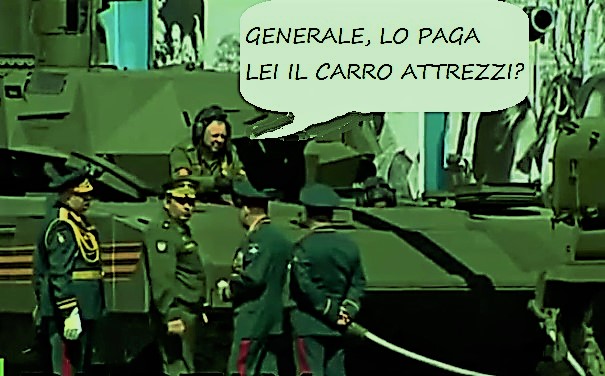
Set 1, 2022 | The Blog
 Dal 2015, la cittadina russa di Kubinka, presso Mosca, ospita un evento dedicato al settore degli armamenti chiamato Army.
Dal 2015, la cittadina russa di Kubinka, presso Mosca, ospita un evento dedicato al settore degli armamenti chiamato Army.
Non è un omaggio alla lingua inglese ma la trascrizione della parola russa che, come in inglese, significa Esercito.
Quest’anno, l’appuntamento è caduto a metà Agosto e ha visto la partecipazione di numerose delegazioni estere, principalmente da nazioni terzomondiste clienti storici di Mosca.
E’ sempre difficile valutare il successo commerciale di fiere di questo tipo, visto che i contratti per le forniture militari si perfezionano in tempi molto lunghi e richiedono spesso interventi della diplomazia a supporto dei produttori di mezzi militari e affini.
Il settore gioca un ruolo molto importante per la Russia, che è il secondo esportatore mondiale di armi dopo gli Stati Uniti, ma nel 2022 le prospettive sono improvvisamente diventate pessime.
Domanda facile facile: Che cosa è avvenuto di diverso quest’anno a guastare la festa di Mosca?
E già, c’è stata l’invasione dell’Ucraina.
Dopo 6 mesi di guerra i russi sono in grosse difficoltà, le armi russe si stanno rivelando inadeguate e il problema è sotto gli occhi di tutti. I potenziali acquirenti di armamenti russi hanno potuto constatare l’inaspettata vulnerabilità dei mezzi corazzati russi e al tempo stesso la micidiale efficacia di quei sistemi d’arma prodotti da USA, Gran Bretagna, Francia, Germania e Svezia, che hanno devastato l’esercito russo.
Difficile dimenticare le immagini diventate quasi giornaliere di tank russi che esplodono proiettando in aria la torretta a decine di metri di altezza e uccidendo all’istante l’equipaggio. “Questo nel video demo non l’avevate mostrato”, potrebbe obiettare il dignitario in visita dal subcontinente indiano. Nemmeno la promessa di una valigia piena di dollari servirà a rassicurarlo sulla qualità del mezzi corazzati russi.
E poi, che fine hanno fatto i tanto decantati carri T-14 Armata, i primi ad essere progettati dopo il crollo dell’URSS? L’esercito russo ne aveva ordinato un primo lotto di 2.300 dopo il debutto pubblico nel 2015. Dovevano essere consegnati due anni fa, ma ne sono in circolazione solo una ventina. Quest’anno un T-14 si è guastato durante le prove della parata militare della vittoria (la vittoria del 1945, beninteso) e ha costretto gli organizzatori a inventarsi una grottesca bufala di stile USSR: “Era tutto studiato. Volevamo dimostrare come si recupera un carro immobilizzato.” Balle da scolaretti di terza elementare.
E’ anzi molto probabile che il T-14 resti un progetto incompiuto. La ditta che lo produce è il difficoltà economiche, le sanzioni hanno bloccato la disponibilità di componenti chiave e probabilmente nessuno lo vuole dopo le pessime prestazioni dei T-72 e T-80 in Ucraina.
Lo stesso dicasi per l’aviazione russa e i suoi cavalli di battaglia. Il tanto decantato caccia della Quinta Generazione, il Sukhoi SU-57, già faceva fatica ad essere prodotto per l’aviazione russa prima delle ultime sanzioni. E comunque, nessun compratore estero si è ancora fatto avanti. Il prevedibile collasso economico di Mosca non è certamente un fattore rassicurante per i potenziali acquirenti.
Eppure, come un disco rotto, Putin continua a sostenere la “superiorità degli armamenti russi”, ma è la classica panzana alla Saddam Hussein destinata al pubblico russo che è notoriamente onnivoro. Grazie a una schiera di propagandisti senza vergogna, queste idiozie influenzano la gente comune che le ripete alla lettera. Il piatto delle esportazioni di armamenti (che nel 2018 valeva oltre 20 miliardi di dollari) è in caduta libera e rischia di arrivare a zero. Anche l’India, maggior compratore di armi russe, guarda la televisione e si interroga sulle sue future scelte. Se Putin avesse il tempo di documentarsi, dovrebbe leggere la “legge delle conseguenze impreviste”, un brillante concetto sviluppato dal sociologo Robert K. Merton nel 1936. (Merton si chiamava in realtà Meyer Robert Schkolnick ed era nato in USA da genitori russi. Com’è piccolo il mondo…)
A Putin rimane sempre l’esportazione dei fucili d’assalto Kalashnikov ai paesi che non applicano sanzioni alla Russia. Sono oggetti di basso valore unitario ma sempre affidabili: non c’è nazione del terzo mondo o gruppo terroristico che ne possa fare a meno. A tutt’oggi l’industria russa è ancora in grado di stampare lamiera e materiali termoplastici. Ma non è detto per quanto, visto che la produzione di automobili è crollata dell’80% e la Kontsern Kalashnikov è in serie difficoltà economiche.
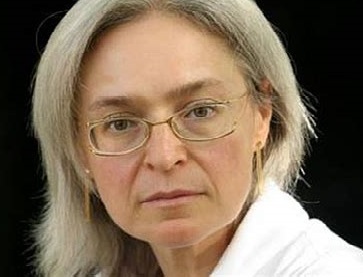
Ago 23, 2022 | The Blog
Darya Dugina, the daughter of extremist Russian firebrand Alexander Dugin, notoriously died when her car blew up in a Moscow suburb a few days ago. Talk about poetic justice.
Not only was she the daughter of one of the ideological instigators of the invasion of Ukraine (he was known as Putin’s Rasputin), but she was also a militant neo-Nazi in her own right.
I hasten to add, she’s not the woman in the picture. She wishes…
In a matter of hours, if the Russian propaganda machine is to be believed, the FSB* has solved the case and identified a “person of interest”, a Ukrainian citizen (now, that comes as a surprise!) who is said to have fled to Estonia after the attack. All this in the best Russian tradition of “zero evidence.”
In my head, I hear someone saying, “We don’t need no steenkin’ evidence” in a heavy Russian accent.
To crack such a case in just two days is akin to science fiction, especially if you consider the FSB’s less-than-stellar record.
- Boris Nemtsov (1959-2015) was a liberal politician who had served as deputy Prime Minister under Boris Yeltsin. A fierce critic of Vladimir Putin, Nemtsov was gunned down by a commando of Chechen assassins in the vicinity of the Kremlin. 2,733 days later, the investigation aimed at identifying the mastermind of this murder has produced no results.
- Natalya Estemirova was a Russian civil-rights activist who was abducted and murdered in Grozny, Chechnya, in 2009. Estemirova had denounced numerous civil rights violations by the Russian troops and their Kadyrovite proxies. Her body was found in a ditch near the town of Gazi-Yurt, some 80 kms to the west of Grozny. 4,786 days later, her murder has become a “cold case” that won’t be solved anytime soon—or ever.
- Anna Politkovskaya (photo) was an American-born journalist who spent seven years in Chechnya covering the second Chechen war in spite of constant harassment and intimidation by the Russian military.
 She wrote for the Novaya Gazeta as an investigative journalist who did not pull any punches in criticizing Putin. Politkovskaya was killed in 2006 by a hit-team of five men. The killers got a prison sentence but the person who orchestrated the hit was never found—at least in the 5,798 days that elapsed since Politkovskaya’s death.
She wrote for the Novaya Gazeta as an investigative journalist who did not pull any punches in criticizing Putin. Politkovskaya was killed in 2006 by a hit-team of five men. The killers got a prison sentence but the person who orchestrated the hit was never found—at least in the 5,798 days that elapsed since Politkovskaya’s death.
But today Vladimir Putin is satisfied that his FSB has found the culprit of Darya Dugin’s assassination in just 48 hours.
If any evidence to the contrary should surface, how sure are we that we’ll ever know?
*Since 1995 the FSB is Russia’s security service, the main heir of the infamous KGB of Soviet memory. In Moscow it occupies the same building, known as the Lubyanka.
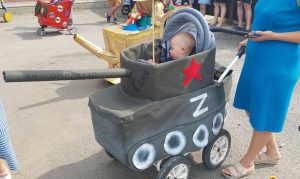
Ago 15, 2022 | The Blog
 We are all aware of the crimes against humanity committed by Russia during its unwarranted and illegal invasion of Ukraine. Most of us have been horrified at the harsh imagery of civilians gunned down on city streets, the contents of their shopping bags strewn all over the pavement. We have witnessed the grim discovery of mass graves in Bucha and elsewhere, we’ve read about the forced deportation of Ukrainian civilians to remote areas of Eastern Russia.
We are all aware of the crimes against humanity committed by Russia during its unwarranted and illegal invasion of Ukraine. Most of us have been horrified at the harsh imagery of civilians gunned down on city streets, the contents of their shopping bags strewn all over the pavement. We have witnessed the grim discovery of mass graves in Bucha and elsewhere, we’ve read about the forced deportation of Ukrainian civilians to remote areas of Eastern Russia.
It would be fair to say that the genocide being perpetrated by Russia is a ghastly reality—and that the much-overrated UN is actually powerless to stop it. It’s 1938 all over again.
If this were not enough, however, there is another, stealthy genocide taking place in Ukraine at the hands of the same perpetrators. It’s the willful extermination of minority recruits from far-away parts of the Russian Federation (RF) sent to their deaths with inadequate training and grossly unsatisfactory equipment.
Most of the human resources thrown into the meat grinder of the Ukraine invasion come from poor and illiterate communities of the RF, not from the big cities . And it’s not a random occurrence, either, but a deliberate choice. These people don’t have a voice in today’s Russia and the mainstream media—that grotesque propaganda circus that befuddles the already unsophisticated Russian public—will never reveal their tragedy.
All it takes to grasp the magnitude of this stealthy genocide is to examine the data for the main “catchment areas” where the RF draws its cannon fodder from. Then you cross this data with the number of combat deaths by area of origin and you’ll realize the most penalized communities are the Dagestanis, the Tyvans and the Buryats.
Dagestan is situated in the northern Caucasus and borders the Caspian Sea to the east. Tyvans come from south-central Siberia,while Buryats inhabit a region situated further east, along the eastern shore of Lake Baikal.
Statistics of combat deaths in Ukraine show that a Dagestani soldier is 87.5 times more likely to die in the war than a recruit from Moscow or Saint Petersburg, while a Tyvan soldier is 350 times more likely to be killed in Ukraine than his “pure Slav” comrades. Marginally more fortunate are the Buryats, for whom a violent death on the battlefield is 275 times more likely than for the above mentioned urban Russians. It is then clear how this war serves Moscow also as a tool for ethnic cleansing within the RF.
If Putin’s actions affecting the Ukrainians were not repulsive enough, this one is another egregious crime against humanity he will have to answer for.
Photo: A patriotic Russian mother participates in a contest for the most creative baby stroller in Sudogda, a town located between Moscow and Nizhny Novgorod. She probably thought her effort was for a good cause (and therein lies the problem.) The term “useful idiots” was invented in Russia for a good reason.









